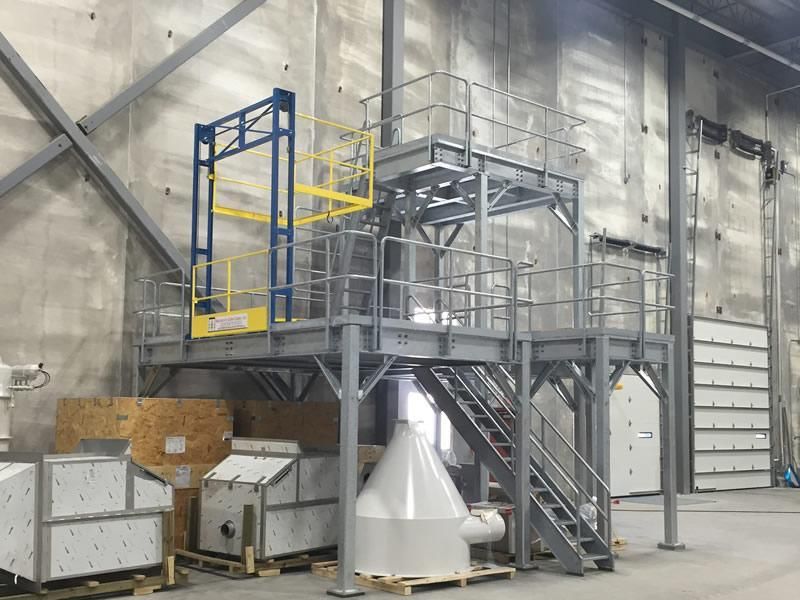
Mixing Platforms and Safety
Chemical manufacturing facilities often have space issues when it comes to safety. Many of these plants have large reactors or mixers with hoppers accessed by elevated platforms positioned near the top of the vessels. Typically a lift truck will load pallets of ingredients onto these upper levels for employees to load into these mixers. So while positioned near a ledge, often unguarded, they are asked to remove heavy bags from a pallet, slice them open and pour them into the large mixer.
Space is often limited on these platforms so that the mixer is located near the pallet of ingredients to limit the distance the operator has to travel with a heavy bag. Often the area consists of a series of catwalks and small mezzanines around the mixer and the production machinery. This limited space is often an issue, leaving very little room for employee, product and proper fall protection guarding, which can expose employees to a high risk for incidents like falls.
We worked with a global manufacturer that works with chemicals to secure three areas in its facility. Each area featured a mixer with a set of platforms and catwalks on which employees were handling and creating the product.
The three platforms offered the additional challenge of very tight space constraints. The pallet drop areas were loaded with a lift truck, and safety relied upon a piece of chain to restrain people — not enough to keep employees safe.
This application is fairly common, outside of the manufacturer’s unique space constraints. All pallet drop areas on elevated platforms need to be properly guarded, but areas on production platforms where employees are asked to work around the ledge, often in a hostile environment, need to be taken seriously. This is often tiring, repetitive work in a dusty or wet environment so companies must take safety out of employee’s hands, giving them one less thing to think about during the day.
Due to the complexity of the areas that needed to be secured, custom dual-gate safety solutions were created. The first area had little room to accommodate a safety barrier so the gate had to be worked into the existing framework of the platform. A custom Pivot Gate was created to be affixed to the handrail instead of the walkway floor to provide dual-gate protection while taking up a minimum amount of space.
The second area pallet drop area had special requirements because a 48-inch pallet had to be able to rotate 360 degrees on a pallet turntable within the guarded area. This area offered additional challenges: there was low overhead, it was situated on a traffic aisle so there were very specific ways the lift truck entered the platform, and the equipment and a ramp to the mixer infringed on how the gate could be used. We created a custom version of High Pallet Pivot model, a dual-gate system that included 14 pivot points that extended the depth and width to accommodate the pallet. The system allowed the pallet to rotate on a turntable, ensuring ease of work and safety on the platform.
The third area had even less available depth due to the location of the blending hopper, which was positioned close to the ledge so the employee could simply turn and dump the bag of ingredients from the pallet into the hopper without carrying the bag. The limited available depth didn’t provide adequate room for a more traditional dual-gate system like the Pivot Model. We installed our Tri-Side design, which uses a fixed support frame only 14” deep, and a rear-side gate that raised up and out of the way when the ledge-side gate was closed, allowing access around the pallet. With this system in place, the employee could grab the bags around the pallet and dump them freely into the hopper, all while a barrier was in place at the ledge to prevent a fall.
All of these dual-gate systems we created - as well as hundreds of other solutions we have created - have worked to keep employees safe on the elevated platforms, as well as meet ANSI standards - while keeping operational processes intact.